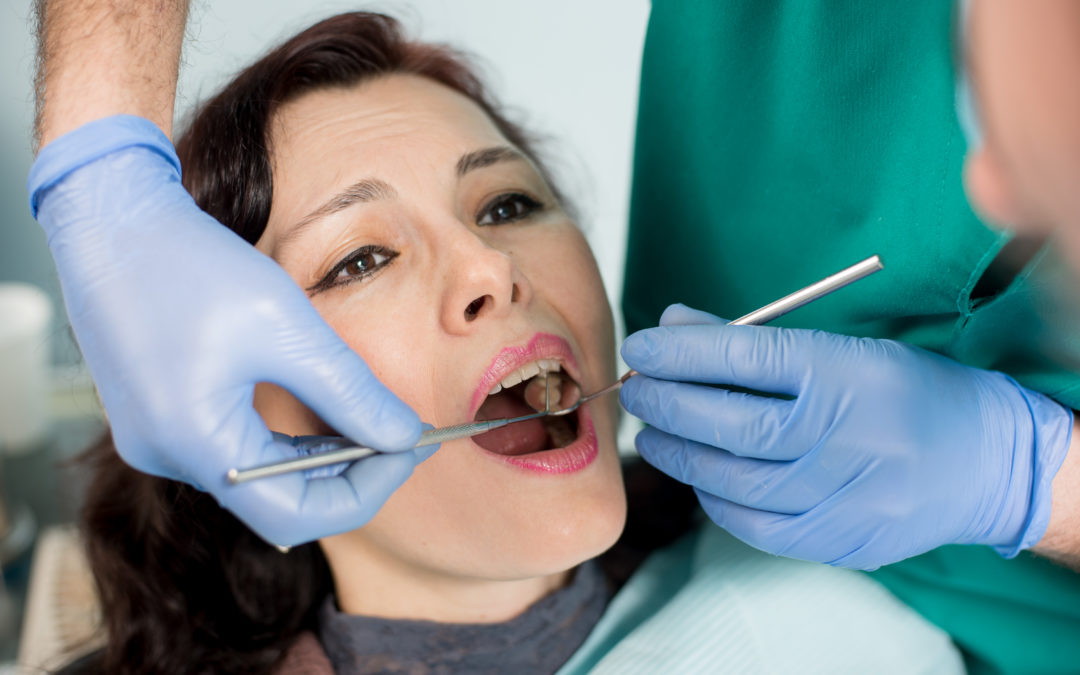Gum disease is a common problem that affects millions of Americans every year. According to the CDC, almost half of adults over age 30 have some form of periodontal disease. If left untreated, gum disease can wreak havoc on your oral health and can cause other serious health problems such as heart disease, strokes, diabetes, and even premature death. Fortunately, early detection and treatment can prevent these complications from occurring.
Early signs of gum disease include swollen or tender gums, bleeding after brushing or flossing, and halitosis (bad breath). If you notice any of these symptoms, schedule a visit with your dentist immediately. Your dentist will perform a thorough examination to determine whether you have periodontal disease. Depending on the severity of your condition, he/she may recommend a series of surgical or non-surgical treatments.
Before we dive more deeply into the early symptoms of gum disease, here are some important terms to know:
- Gingivitis: a mild form of gum disease that causes inflammation of the gums
- Periodontal Disease: a gum infection that damages the gums, teeth, and jawbone
- Gum Disease: a common term used to describe periodontal disease
- Periodontitis: another term used to describe periodontal disease, usually in its more severe stages
- Periodontist: a dentist who specializes in treating and preventing periodontal disease
- Periodontal Treatment: dental treatment to clean the pockets around teeth and treat gum disease
What is Gum Disease?
Gum disease occurs when bacteria build up under the gums causing inflammation and infection. This leads to bleeding, swelling, pain, bad breath, tooth sensitivity, and eventually loose teeth and tooth loss.
4 Stages of Gum Disease
Gum disease is progressive, and if left untreated, will continue to worsen. There are 4 stages of gum disease.
- Gingivitis: is characterized by red and swollen gums that may bleed when you brush or floss your teeth. You may also notice bad breath or a bad taste in your mouth. Gingivitis is reversible and can be treated by visiting your dentist regularly for professional cleanings and by improving your oral hygiene routine at home.
- Slight Gum Disease: is the second stage of gum disease, and is manageable, but no longer reversible. While you typically won’t feel any pain, you may notice even more redness, swelling, and bleeding of the gums. At this point, bacteria has spread below the gum line and has compromised the gum tissue and the bone that supports your teeth.
- Moderate Gum Disease: is a more advanced form of periodontitis where bacteria grows deeper below the gum line and starts to eat away at the jaw bone, causing bone loss. At this point, there is a risk of infection spreading into the bloodstream.
- Advanced Periodontitis (severe gum disease): is the most advanced gum disease. With advanced periodontitis, teeth begin to lose their structural support and may become loose. As the disease progresses, you may experience gum recession, abscesses, loss of teeth, and difficulty chewing and swallowing.
What Causes Gum Disease?
Gum disease is caused by bacteria that build up in your mouth, usually due to poor oral hygiene routines. When bacteria isn’t cleared away with regular brushing and flossing, it turns into a sticky film called plaque. Over time, plaque buildup hardens and turns into tartar. Tartar consists of hard, calcified deposits that form on the teeth.
The first image shows plaque buildup on the teeth. The second image shows tartar.

Warning Signs of Gum Disease
The following are early warning signs that you may be developing gum disease:
- Bad breath or a bad taste in your mouth
- Red, swollen, or bleeding gums
- Gum tenderness
- Pain when chewing
- Sensitive teeth
Risk Factors for Gum Disease
Poor oral hygiene is the main cause of gum disease, but there are some other factors that can put you at a higher risk for gum disease:
- Smoking or tobacco use
- Recreational drug use, such as smoking marijuana
- Lack of a balanced diet, or inadequate nutrition
- Diabetes
- Heredity
- Crooked teeth
- Immunodeficiencies like HIV
- Defective fillings, bridges, dentures, or other prosthetics
- Medications that cause dry mouth
- Hormonal changes
What to Do if You Experience Signs of Gum Disease
If you notice any of the warning signs of gum disease, you should contact your dentist to schedule an appointment. If caught early enough, a dental cleaning, changes to your at-home dental routine, an antibiotic gel, or an antimicrobial mouthwash can reverse gingivitis.
Your dentist may want to see you for more frequent check-ups and cleanings if they detect gingivitis. This is to ensure that the condition doesn’t return or worsen between bi-annual appointments.
Treatment for Gum Disease
Since periodontitis is a progressive disease, treatment options vary depending on the stage of gum disease when it is detected and how far the bacteria has spread throughout the mouth. There are both non-surgical and surgical options to treat gum disease:
- More Frequent Dental Care: Your dentist may recommend having more frequent regular cleanings if you’ve had early-stage gum disease in the past.
- Deep Cleaning (Scaling and Root Planing): Deep dental cleanings are also known as scaling and root planing. This is different than the cleaning you get at regular dental checkups. With a deep cleaning, the dental professional will clean beneath the gum line and remove tartar from the tooth roots and spaces between teeth.
- Flap Surgery: This is a type of gum grafting surgery where the gum tissue is lifted away from the teeth so the infected area can be cleaned. The dentist will then secure the gums to encourage re-attachment to the teeth.
- Soft Tissue Grafting: With this dental surgery, the dentist will remove tissue from another part of your body (usually the roof of the mouth) and attach it to receding gums to cover the exposed tooth roots.
- Bone Grafting: Bone grafting may be needed if untreated gum disease has progressed far enough to compromise the bone structure in the jaw. In this case, the dentist may need to use transplanted bone to repair and rebuild the jaw.
How Can Gum Disease Be Prevented?
The best way to prevent gum disease is to keep up with good oral care. This means daily brushing and flossing and regular visits to your dentist at least twice per year. If you are at a higher risk of gum disease, your dentist may want to see you more often than twice per year to ensure you have a healthy mouth.
If you are experiencing any of the early symptoms of gum disease, schedule an appointment with our office to ensure you get professional treatment right away!

